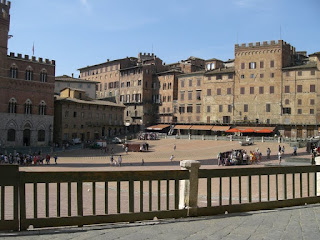Today we took the “Best of Tuscany” tour through a company called Walkabout. We heard about the tour through my sister-in-law. I know this is a bit of an advertisement, but seriously, if you ever have the chance, take this tour. We loved every bit of it.
We started the day by getting in line at the bus station. This is important, because this is where we met Claire and Ryan. We hit it off with them right away and enjoyed their company for the rest of the day. They’re the same age as us, they’re both middle school counselors, and they’re taking a multi-country trip this summer that ends next week in Rome. Who knows, we might even bump into them again there!
That’s them, holding their alarm clock—the only thing they had with them on the trip to keep time! (That’s what happens when you depend solely on your cell phone for the time… and people said watches were out-dated).
Our first stop was Siena, an old town known for its 17 neighborhoods, the oldest bank in the world, and its annual Palio horse races. The entire city only has about 50,000 inhabitants, and the whole thing is small, cramped, and Medieval—so when I say “neighborhood” think “small boroughs.” Each one has its own mascot and my favorite was the caterpillar (represented by the colors yellow and green). Others included giraffe, turtle, she-wolf, goose, forest, and wave.
Now, on to the bank. Originally, the bank was just a bench/booth in the market square. The Italian word for bench is “banco.” You see where this is going? That’s how we got the word “bank!” Okay, but the really cool thing is that if you couldn’t pay your taxes, then the city would send someone out to break your bench with an ax because you had defaulted. So the Italian word for that is “banco rotta”… “bankrupt”!! Cool, right? Check out that old bank!
The Palio takes place twice a year in their central plaza (look them up on Youtube!). They line the buildings with mattresses and such so that the jockeys and/or horses don’t get too badly hurt if they have problems with the tight turns; they truck in loads of sand to cover the street where the horses run; and they pack the center of the track with people. It’s a big freakin’ deal for whoever’s neighborhood horse wins the race. Below is a picture of the plaza, which they call the "sea shell" because of its shape... it's not square.
Our next stop was lunch at an organic vineyard/farm. Nearly everything we ate was produced on-site, including: red wine, white wine, olive oil, fresh bread, pasta, beef, tomato sauce, ham, salami, and even biscoti. They treated us to a wine-tasting with our lunch, so we got to try four of their wines. Additionally, the view was breath-taking, so you can imagine that we didn’t want to leave!
However, we had to move on to our next stop: San Gimignano, sometimes referred to as the “Medieval Manhattan.” We had a direct view of this city the entire time we ate, so it was neat to get to visit in person, too. This place was steaming hot, and it was hard to believe that in the Medieval days, people opted to live there. At one time there were probably as many as 40 towers (although now there are only about 14). The taller the tower, the richer the person—as you can imagine, it was a way of showing off wealth. Imagine this though: these super tall towers were built with safety in mind as a first priority, so there weren’t any windows until the very top level. I can’t even imagine climbing all those stairs in all that stifling heat! We bought some hats to help us cope with the glaring sun.
We ended the day in Pisa. Here’s another thing for you to look up on Youtube: their yearly festival in honor of their patron saint. They call it Luminarius. Too bad we didn’t get to see that in person!
What we did get to see was the leaning tower. Yes! It was there, still leaning. I found it amazing though, that such a small town had such a huge domed church, baptistery (because you couldn’t enter the church until after you were baptized… bit of a conundrum back in the day), and bell tower (“leaning tower”). We learned that each of these small towns that we visited today were all booming cities in the 1000s, 1100s, and 1200s… up until the Black Plague. Two-thirds of their populations were wiped out, and none of these cities ever regained their status, power, or wealth. Fascinating that something that happened thousands of years ago still resonates.
So if you’ve stuck with me, thanks! That was our day in a nutshell. I tried to just make note of either the key points or the fascinating facts. Until next time… ciao!















No comments:
Post a Comment